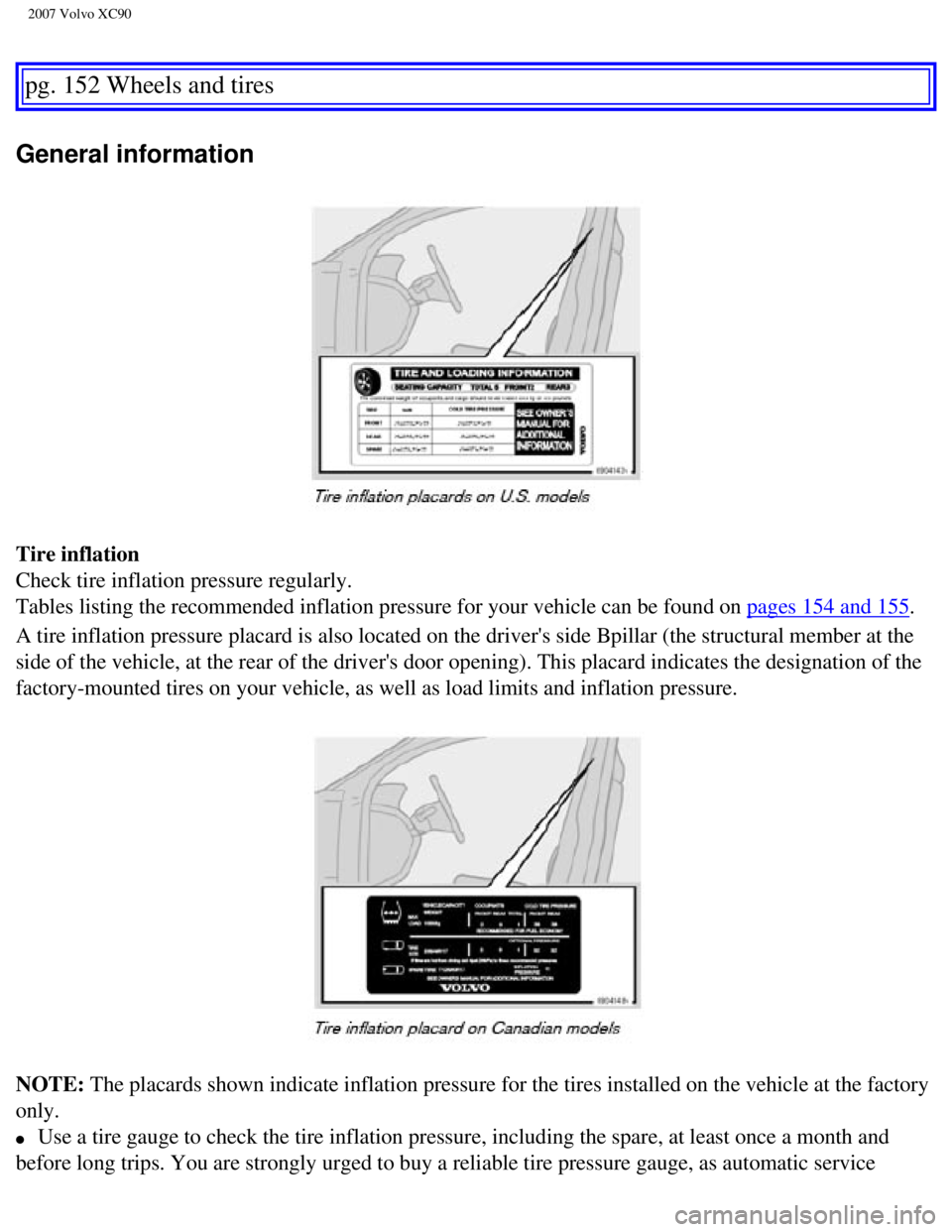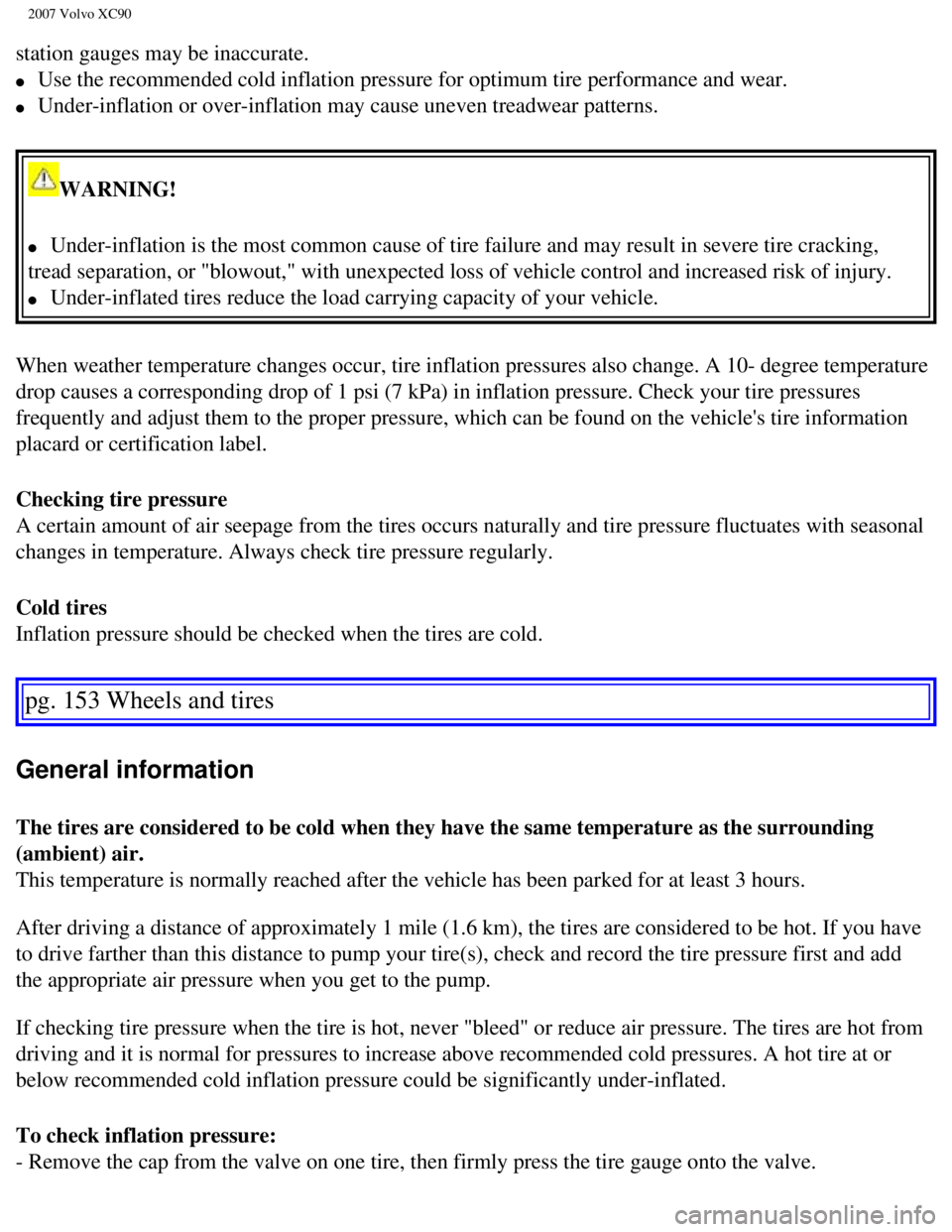2007 VOLVO XC90 wheel
[x] Cancel search: wheelPage 152 of 268

2007 Volvo XC90
W - Winter/Wet driving mode - enhanced vehicle traction
l Mode W will only function if the gear selector is in the (D)rive position.
l Press the button at the base of the gear selector to engage/disengage th\
is driving mode.
l An LED in the button will light up to indicate that W is engaged and thi\
s will also be displayed in the instrument panel
(see
page 46).
l This mode may be selected for starting/ moving off on slippery roads.
1. Synthetic oil is not used when the oil is changed at the normal maint\
enance service intervals except at owner request and at
additional charge. Please consult your Volvo retailer.
pg. 144 Starting and driving
Before a long distance trip
It is always worthwhile to have your vehicle checked at a Volvo retailer\
before driving long distances. Your retailer will
also be able to supply you with bulbs, fuses, spark plugs and wiper blad\
es for your use in the event that problems occur.
As a minimum, the following items should be checked before any long trip\
:
l Check that engine runs smoothly and that fuel consumption is normal.
l Check for fuel, oil, and fluid leakage.
l Check transmission oil level1.
l Check condition of drive belts.
l Check state of the battery's charge.
l Examine tires carefully (the spare tire as well), and replace those th\
at are worn. Check tire pressures.
l The brakes, front wheel alignment, and steering gear should be checked b\
y your Volvo retailer only.
l Check all lights, including high beams.
l Reflective warning triangles are legally required in some states/provinc\
es.
l Have a word with your Volvo retailer if you intend to drive in countries\
where it may be difficult to obtain the correct
fuel.
l Consider your destination. If you will be driving through an area where \
snow or ice are likely to occur, consider snow
tires.
1. To prevent injury from contact with hot surfaces, do not inspect your\
vehicle's transmission fluid yourself. Have your vehicle's
transmission fluid level inspected by a qualified Volvo service technici\
an.
pg. 145 Starting and driving
Blind Spot Information System (BLIS) - option
file:///K|/ownersdocs/2007/2007_XC90/07xc90_06.htm (28 of 32)12/30/200\
6 5:53:44 PM
Page 157 of 268

2007 Volvo XC90
2 0 0 7
VOLVO XC90
Wheels and tires
pg. 149 Wheels and tires
General information 150
Tire inflation pressure tables - U.S. models
154
Tire inflation pressure tables - Canadian models
155
Tire Pressure Monitoring System (TPMS) -
option
156
Tire designations
159
Glossary of tire terminology
160
Vehicle loading
161
Uniform Tire Quality Grading
163
Snow chains, snow tires, studded tires
164
Temporary spare
165
Changing wheels
166
pg. 150 Wheels and tires
General information
Your vehicle is equipped with tires according to the vehicle's tire info\
rmation placard on the B-pillar
(the structural member at the side of the vehicle, at the rear of the d\
river's door opening), or on the inside
of the fuel filler door on Canadian models.
The tires have good road holding characteristics and offer good handling\
on dry and wet surfaces. It
should be noted however that the tires have been developed to give these\
features on snow/ice-free
surfaces.
Certain models are equipped with "all-season" tires, which provide a som\
ewhat higher degree of road
holding on slippery surfaces than tires without the "all-season" rating.\
However, for optimum road
file:///K|/ownersdocs/2007/2007_XC90/07xc90_07.htm (1 of 23)12/30/2006\
5:53:47 PM
Page 158 of 268

2007 Volvo XC90
holding on icy or snow-covered roads, we recommend suitable winter tires\
on all four wheels.
When replacing tires, be sure that the new tires are the same size desig\
nation, type (radial) and
preferably from the same manufacturer, on all four wheels. Otherwise the\
re is a risk of altering the
vehicle's roadholding and handling characteristics.
Storing wheels and tires
When storing complete wheels (tires mounted on rims), they should be s\
uspended off the floor or placed
on their sides on the floor.
Tires not mounted on rims should be stored on their sides or standing up\
right, but should not be
suspended. CAUTION!
Tires should preferably be stored in a cool, dry, dark place, and should\
never be stored in close
proximity to solvents, gasoline, oils, etc.
Tread wear indicator
The tires have wear indicator strips running across or parallel to the t\
read. The letters TWI are printed on
the side of the tire. When approximately 1/16" (1.6 mm) is left on the\
tread, these strips become visible
and indicate that the tire should be replaced. Tires with less than 1/16\
" (1.6 mm) tread offer very poor
traction.
When replacing worn tires, it is recommended that the tire be identical \
in type (radial) and size as the
one being replaced. Using a tire of the same make (manufacturer) will \
prevent alteration of the driving
characteristics of the vehicle.
pg. 151 Wheels and tires
file:///K|/ownersdocs/2007/2007_XC90/07xc90_07.htm (2 of 23)12/30/2006\
5:53:47 PM
Page 159 of 268

2007 Volvo XC90
General information
WARNING!
l The wheel and tire sizes for your Volvo are specified to meet stringent \
stability and handling
requirements. Unapproved wheel/tire size combinations can negatively aff\
ect your vehicle's stability
and handling. Approved tire sizes are shown in the Tire inflation pressu\
re tables on
page 154.
l Any damage caused by installation of unapproved wheel/tire size combinat\
ions will not be covered
by your new vehicle warranty. Volvo assumes no responsibility for death,\
injury, or expenses that
may result from such installations.
New tires
Remember that tires are perishable goods. As of 2000, the manufacturing \
week and year will be
indicated with 4 digits (e.g. 1502 means that the tire illustrated was \
manufactured during week 15 of
2002).
Tire age
Tires degrade over time, even when they are not being used. It is recomm\
ended that tires generally be
replaced after 6 years of normal service. Heat caused by hot climates, f\
requent high loading conditions
or Ultra Violet (U.V) exposure can accelerate the aging process.
You should replace the spare tire when you replace the other road tires \
due to the aging of the spare.
A tire's age can be determined by the DOT stamp on the sidewall (see th\
e illustration above).
A tire with e.g., visible cracks or discoloration should be replaced imm\
ediately.
Improving tire economy:
l Maintain correct tire pressure. See the tire pressure table on page 154.
l Drive smoothly: avoid fast starts, hard braking and tire screeching.
l Tire wear increases with speed.
l Correct front wheel alignment is very important.
l Unbalanced wheels impair tire economy and driving comfort.
l Tires must maintain the same direction of rotation throughout their life\
time.
When replacing tires, the tires with the most tread should be mounted on\
the rear wheels to reduce the
chance of oversteer during hard braking.
Hitting curbs or potholes can damage the tires and/or wheels permanently\
.
file:///K|/ownersdocs/2007/2007_XC90/07xc90_07.htm (3 of 23)12/30/2006\
5:53:47 PM
Page 160 of 268

2007 Volvo XC90
pg. 152 Wheels and tires
General information
Tire inflation
Check tire inflation pressure regularly.
Tables listing the recommended inflation pressure for your vehicle can b\
e found on
pages 154 and 155.
A tire inflation pressure placard is also located on the driver's side B\
pillar (the structural member at the
side of the vehicle, at the rear of the driver's door opening). This pl\
acard indicates the designation of the
factory-mounted tires on your vehicle, as well as load limits and inflat\
ion pressure.
NOTE: The placards shown indicate inflation pressure for the tires installed \
on the vehicle at the factory
only.
l Use a tire gauge to check the tire inflation pressure, including the spa\
re, at least once a month and
before long trips. You are strongly urged to buy a reliable tire pressur\
e gauge, as automatic service
file:///K|/ownersdocs/2007/2007_XC90/07xc90_07.htm (4 of 23)12/30/2006\
5:53:47 PM
Page 161 of 268

2007 Volvo XC90
station gauges may be inaccurate.
l Use the recommended cold inflation pressure for optimum tire performance\
and wear.
l Under-inflation or over-inflation may cause uneven treadwear patterns.
WARNING!
l Under-inflation is the most common cause of tire failure and may result \
in severe tire cracking,
tread separation, or "blowout," with unexpected loss of vehicle control \
and increased risk of injury.
l Under-inflated tires reduce the load carrying capacity of your vehicle. \
When weather temperature changes occur, tire inflation pressures also ch\
ange. A 10- degree temperature
drop causes a corresponding drop of 1 psi (7 kPa) in inflation pressur\
e. Check your tire pressures
frequently and adjust them to the proper pressure, which can be found on\
the vehicle's tire information
placard or certification label.
Checking tire pressure
A certain amount of air seepage from the tires occurs naturally and tire\
pressure fluctuates with seasonal
changes in temperature. Always check tire pressure regularly.
Cold tires
Inflation pressure should be checked when the tires are cold.
pg. 153 Wheels and tires
General information
The tires are considered to be cold when they have the same temperature \
as the surrounding
(ambient) air.
This temperature is normally reached after the vehicle has been parked f\
or at least 3 hours.
After driving a distance of approximately 1 mile (1.6 km), the tires a\
re considered to be hot. If you have
to drive farther than this distance to pump your tire(s), check and re\
cord the tire pressure first and add
the appropriate air pressure when you get to the pump.
If checking tire pressure when the tire is hot, never "bleed" or reduce \
air pressure. The tires are hot from
driving and it is normal for pressures to increase above recommended col\
d pressures. A hot tire at or
below recommended cold inflation pressure could be significantly under-i\
nflated.
To check inflation pressure:
- Remove the cap from the valve on one tire, then firmly press the tire \
gauge onto the valve.
file:///K|/ownersdocs/2007/2007_XC90/07xc90_07.htm (5 of 23)12/30/2006\
5:53:47 PM
Page 162 of 268

2007 Volvo XC90
- Add air to reach the recommended air pressure.
- Replace the valve cap.
- Repeat this procedure for each tire, including the spare.
- Visually inspect the tires to make sure there are no nails or other ob\
jects embedded that could puncture
the tire and cause an air leak.
- Check the sidewalls to make sure there are no gouges, cuts, bulges or \
other irregularities.
NOTE:
l If you overfill the tire, release air by pushing on the metal stem in th\
e center of the valve. Then
recheck the pressure with your tire gauge.
l Some spare tires require higher inflation pressure than the other tires.\
Consult the tire inflation table
on
page 154 or see the inflation pressure placard.
pg. 154 Wheels and tires
Tire inflation pressure tables - U.S. models
The following tire pressures are recommended by Volvo for your vehicle. \
Refer to the tire inflation
placard for information specific to the tires installed on your vehicle \
at the factory.
Cold tire pressures up to five persons
Tire size Front, psi
(kPa) Rear, psi (kPa)
XC90
235/65R17
235/60R18
255/50R19 36 (250)
36 (250)
Temporary spare tire
T155/85R18 61 (420)
61 (420)
Load ratings
The load ratings in the tables above translate as follows:
91 = 1365 lbs (615 kg), 93 = 1433 lbs (650 kg), 99 = 1709 lbs (755 \
kg)
Speed ratings
The speed ratings in the tables translate as follows:
M = 81 mph (130 km/h), V= 149 mph (240 km/h), W= 168 mph (270 km/h)\
See also
page 159 for an explanation of the designations on the sidewall of the tire.
file:///K|/ownersdocs/2007/2007_XC90/07xc90_07.htm (6 of 23)12/30/2006\
5:53:47 PM
Page 163 of 268

2007 Volvo XC90
pg. 155 Wheels and tires
Tire inflation pressure tables - Canadian models
The following tire pressures are recommended by Volvo for your vehicle. \
Refer to the tire inflation
placard for information specific to the tires installed on your vehicle \
at the factory.
Tire size Cold tire pressures
up to five persons psi (kPa) Optional pressure
up to three persons psi (kPa)
FrontRear Front Rear
225/70R16
235/65R17
235/60R18
255/50R19 39 (270
39 (270) 32 (220) 32 (220)
Temporary spare tire
T155/85R18 61 (420)
61 (420) 61 (420) 61 (420)
pg. 156 Wheels and tires
Tire Pressure Monitoring System (TPMS) - option
The tire pressure monitoring system uses sensors mounted in the tire val\
ves to check inflation pressure
levels. When the vehicle is moving at a speed of approximately 20 mph (\
30 km/h) or faster, these
sensors transmit inflation pressure data to a receiver located in the ve\
hicle.
USA - FCC ID: MRXTG315AM04
This device complies with part 15 of the FCC rules. Operation is subject\
to the following conditions:
(1) This device may not cause harmful interference, and (2) this dev\
ice must accept any interference
received, including interference that may cause undesired operation.
When low inflation pressure is detected, TPMS will light up the tire pre\
ssure warning light (
) (also
referred to as a telltale) in the instrument panel, and will display a \
message in the text window. The
wording of this message is determined by the degree of inflation pressur\
e loss.
NOTE: If a fault occurs in TPMS, the tire pressure warning light will flash f\
or approximately 1 minute
and TIRE PRESS SYST SERVICE REQUIRED will be displayed.
file:///K|/ownersdocs/2007/2007_XC90/07xc90_07.htm (7 of 23)12/30/2006\
5:53:47 PM